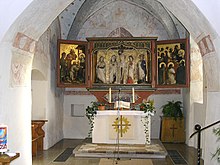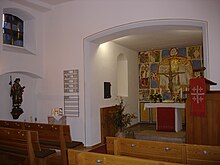Franconian-Swabian Way of St. James


The Franconian-Swabian Way of St. James was established in 1999 as a connection of the Franconian Way of St. James from Würzburg or Nuremberg via Rothenburg ob der Tauber and the Ostalb to Ulm . There it connects to the Upper Swabian Way of St. James , which leads from Ulm Minster to Lake Constance .
Origin in the 20th century
Two theologians who were ecumenically friendly with each other gave decisive impetus for the modern design of the path : Pastor Sieger Köder , who was pastor of the St. Jakobus parish Hohenberg in the parish of Rosenberg from 1975 to 1995 , and Pastor Wolfgang Lipp . Lipp, inspired by bait, has evaluated many old sources in a long process of sifting and collecting that historically substantiate a probable course of the route. The result is an extensive study of the southern German Way of St. James and their feeders, which gradually enabled a practical route. But Lipp emphasizes: “A Way of St. James in southern Germany can never be as unambiguous as it is in France. [...] It is also not to be expected that the stations can be firmly determined [...] like pearls on a string. The Jacob pilgrims took advantage of the facilities [in southern Germany] that were available for all pilgrims and hikers. "
Dieter Klaschuweit and Wolfgang W. Meyer also describe this path in detail, but in their preliminary remark they assume that the “crossing over the Alb can not be an original route”, “because the pilgrims avoided major differences in altitude”. They are convinced that countless pilgrims "tended to go into the valleys" and headed westwards through the Remstal Cannstatt .
Routing
Today's normal route

The Franconian-Swabian Way of St. James leads in its more detailed version from Würzburg, but in its more concise form in about eight daily stages from Rothenburg ob der Tauber through the Jakobstor to Wallhausen north of Crailsheim (29 km), from there to Frankenhardt - Oberspeltach , west of Crailsheim (27 km), then on to the Hohenberg in the municipality of Rosenberg with its widely visible Jakobuskirche (18 km), from Hohenberg to Abtsgmünd -Wöllstein (22 km), from the Kochertal there over into the Remstal to Böbingen (18 km).
From Böbingen in the Remstal valley, the path leads steeply via Bargau to the Swabian Alb up to the Albtrauf, where it crosses the Swabian Alb northern edge path . In a short distance, a pilgrim covers almost 300 meters in altitude, because Bargau is 432 m , the so-called Kingdom of Heaven on the Albtrauf already 698 m above sea level.
The Way of St. James continues to Böhmenkirch (24 km), from there over the plateau of the Swabian Alb to Gussenstadt , Sontbergen, Zähringen, Ettlenschieß to Lonsee (28 km). In another day's march, the route leads via Scharenstetten , Temmenhausen , Bollingen , Mähringen , the Eselsberg to Ulm (30 km).
Variants, branches and connections
There are also other parts of the network of the Way of St. James in Franconia and Swabia that are not covered by this route. In 2008 a Göppingen Jakobsweg was signposted, which intersects the Franconian-Swabian in Bargau. From the east, "the Middle Franconian Jakobusweg joins Rothenburg ob der Tauber , which begins in Nuremberg after the long-distance route from Prague has been taken up there". Furthermore, a route probably leads from Rothenburg ob der Tauber via Schwäbisch Hall to the west into the Neckar Valley .
The Franconian-Swabian Way of St. James ends, together with the Franconian Way of St. James, directly from Nuremberg, at the Ulm Minster and is continued from there as the Upper Swabian Way of St. James to Constance on Lake Constance.
Marking and description
The Franconian-Swabian Way of St. James is marked almost continuously with a white Jakobus shell on a blue background. It is described in detail by Wolfgang W. Meyer. Further signs are attached to many turns, followed by stickers and small hiking boards.
Along the way, pilgrims can get stamps for the pilgrim ID in various churches .
Stations along the route
In Bräunisheim, the local coat of arms even contains a double scallop shell .
Also in Halzhausen near Lonsee, symbols of the Way of St. James can be found in the local coat of arms.
At the Marienkirche in Lonsee, the Way of St. James crosses the Lone Valley .
See also
literature
- Erich Baierl, Wolfgang Dettling, Peter Högler, Johann Rebele: On the Jakobsweg from Würzburg via Rothenburg odT and Hohenberg to Ulm. Seehars-Verlag, Uffenheim 2010, ISBN 978-3-927598-27-0
- Wolfgang Lipp : The way to Santiago - Way of St. James in southern Germany , Ulm 1991, ISBN 3-88294-164-2
- Wolfgang W. Meyer, Way of St. James. Württemberg - Baden - Franconia - Switzerland. Tübingen 2006, 5th edition, ISBN 978-3-87407-726-2
Web links
- Franconian-Swabian Way of St. James from Würzburg to Ulm on the website of Wandersüden.de
- Website of the municipality of Rosenberg with information on the pilgrimage route
Individual evidence
- ↑ so especially Dieter Klaschuweit and Wolfgang W. Meyer, The Franconian-Swabian St. James, pp 189-227, in: Wolfgang W. Meyer, Jacob ways. Württemberg - Baden - Franconia - Switzerland. Tübingen 2006, 5th edition, p. 190
- ↑ so rather Wolfgang Lipp, The way to Santiago, Jakobuswege in Süddeutschland , Ulm 1991, p. 128 u. a.
- ↑ Wolfgang Lipp, The Way to Santiago , Ulm 1991, p. 11
- ↑ Wolfgang Lipp, Der Weg nach Santiago , Ulm 1991, 239 pages
- ↑ Wolfgang Lipp, The Way to Santiago, Ulm 1991, p. 23
- ↑ Dieter Klaschuweit and Wolfgang W. Meyer, Der Fränkisch-Schwäbische Jakobsweg, pp. 189–227, in: Wolfgang W. Meyer, Jakobswege. Württemberg - Baden - Franconia - Switzerland. Tübingen 2006, 5th edition, p. 190
- ↑ Dieter Klaschuweit and Wolfgang W. Meyer, Der Fränkisch-Schwäbische Jakobsweg , pp. 189–227, in: Wolfgang W. Meyer, Jakobswege. Württemberg - Baden - Franconia - Switzerland. Tübingen 2006, 5th edition, p. 190
- ↑ Dieter Klaschuweit and Wolfgang W. Meyer, Der Fränkisch-Schwäbische Jakobsweg , pp. 189–227, in: Wolfgang W. Meyer, Jakobswege. Württemberg - Baden - Franconia - Switzerland. Tübingen 2006, 5th edition, p. 189
- ↑ Wolfgang W. Meyer, Jakobswege. Württemberg - Baden - Franconia - Switzerland. Tübingen 2006, 5th edition, p. 28 and p. 190
- ↑ Wolfgang W. Meyer, Jakobswege. Württemberg - Baden - Franconia - Switzerland. Tübingen 2006, 5th edition, ISBN 978-3-87407-726-2 , SS 189–227








